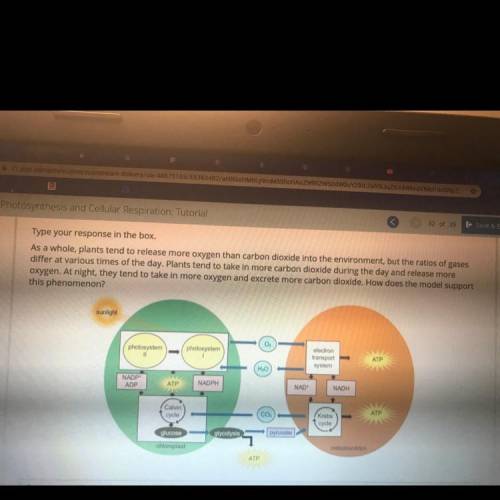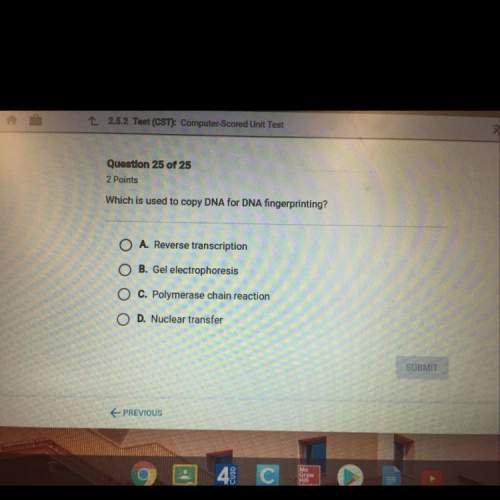
Biology, 02.03.2021 18:30 xarianna2007
Type your response in the box.
As a whole, plants tend to release more oxygen than carbon dioxide into the environment, but the ratios
of gases
differ at various times of the day. Plants tend to take in more carbon dioxide during the day and release more
oxygen. At night, they tend to take in more oxygen and excrete more carbon dioxide. How does the model support
this phenomenon?
Please don’t give me the Plato answer. Don’t comment also if you don’t truly know the answer just to get free points.


Answers: 1


Other questions on the subject: Biology

Biology, 22.06.2019 07:30, tamerrapittsoy4ii6
Pls need ! in your opinion, what are the limiting factors that might affect the growth or diversity of our ecosystem? respond to this question in claim, evidence, reasoning format. 1. make your claim (i are the limiting factors that might affect the growth or diversity of our 2. follow the claim with 3 pieces of evidence. evidence may be taken from the reading, the videos, previous lessons, or googled answers. site sources, too. 3. use reasoning to explain why you chose your evidence.
Answers: 2


Biology, 22.06.2019 19:20, Bradgarner772
What is the relative placement of the moon, earth and sun during a lunar eclipse? the sun, earth and moon are aligned with the earth in the middle and the moon furthest away from the sun. the moon and sun are aligned with the earth at right a right angle to the moon. the sun, earth and moon are aligned with the moon in the center and the earth furthest away from the sun. the earth and sun are aligned with the moon is at a right angle to earth. 2. choose the best explanation of a partial solar eclipse. during a new moon phase there is usually a partial but not total eclipse. the earth only partially covers the sun during the eclipse. the moon only partially covers the sun during the eclipse. the moon only partially covers the sun during the eclipse. the moon's phase is full and blocks out most but not all of the sun. 3. what are conditions necessary for a total solar eclipse? moon in perigee orbit, earth a direct line between sun and moon, moon in full moon phase moon in perigee orbit; moon moves a direct line between sun and earth; moon in full moon phase moon in perigee orbit; moon moves a direct line between sun and earth; moon in new moon phase moon in apogee orbit, moon moves a direct line between sun and earth; moon in new moon phase 4. what causes a partial lunar eclipse? only the penumbra of the earth passes across the moon creating a circular shadow. the earth's umbra fits inside the moon creating an illuminated ring known as a annular eclipse. a partial eclipse causes the moon to turn reddish from the refraction of the sun's ray through the earth atmosphere. the earth's umbra only cover a part of the moon causing a circular shadow to pass across it.
Answers: 1

Biology, 22.06.2019 23:00, flippinhailey
Atype of organism that no longer exist on earth is said to be
Answers: 2
You know the right answer?
Type your response in the box.
As a whole, plants tend to release more oxygen than carbon dioxide i...
Questions in other subjects:


Biology, 04.11.2020 19:00


English, 04.11.2020 19:00

Arts, 04.11.2020 19:00

Mathematics, 04.11.2020 19:00


Geography, 04.11.2020 19:00





